Bulletin – April 1997 Recent Developments in Small Business Finance
- Download 39KB
Introduction
In 1993, a Small Business Panel was formed by the Reserve Bank to advise it on the availability of finance to small business. At about the same time, a detailed collection of data on banks' lending to small business was instituted.[1] These data have been published on a quarterly basis in the Bulletin as Table B.17. Now that there is a sufficient run of years to present them as a time series, a new table (B.18) has been added in this issue of the Bulletin.
This article discusses recent trends in these data, as well as more general issues in financing of small business. An earlier article on bank lending to small business appeared in the April 1994 Bulletin.
Cost of Finance
Small business operators look to the banking sector to provide most of their needs for debt finance, so changes in the types of loan products offered by banks, and in the interest rates on these loans, have a major bearing on the sector's financing costs.
Three broad types of finance are offered by banks:
- loans on which the interest rate is variable. Typical loans in this category are overdrafts. The interest rate on these loans comprises two components – an indicator rate, which tends to vary over time due to such things as changes in monetary policy, and a customer risk margin which varies across customers to reflect differences in risk;[2]
- loans on which the interest rate is fixed at the time the loan is taken out. These loans are usually for a fixed amount and a fixed term – typically 3 to 5 years. These loans are priced at a margin over capital market interest rates for the relevant term. A customer risk margin may also be applied; and
- bill lines. These are priced in relation to bank bill yields in the money market, again plus a margin.
Interest rates on all these products have fallen substantially since mid 1996, mainly in response to the easings of monetary policy and the fall in capital market interest rates that have accompanied the decline in inflation (Graph 1).
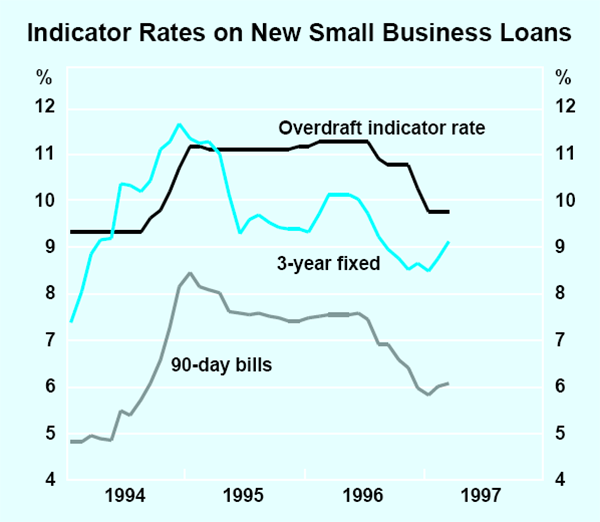
On variable-rate loans, indicator rates fell by 1.5 percentage points in the second half of 1996, in line with the fall in cash rates as monetary policy was eased. This reduced the indicator rate to 9.75 per cent. The overall interest rate paid by business also incorporates a customer risk margin; this varies from business to business, but on average is around 2 percentage points for small businesses.
The current level of interest rates on variable-rate loans is slightly above the lows reached before the 1994 tightenings and, apart from that period, at its lowest since the early 1970s (Graph 2). This return to low levels of interest rates has been made possible by the falls in inflation in recent years. As outlined below, this has had major benefits to all businesses, including small businesses, in terms of lowering overall interest costs.
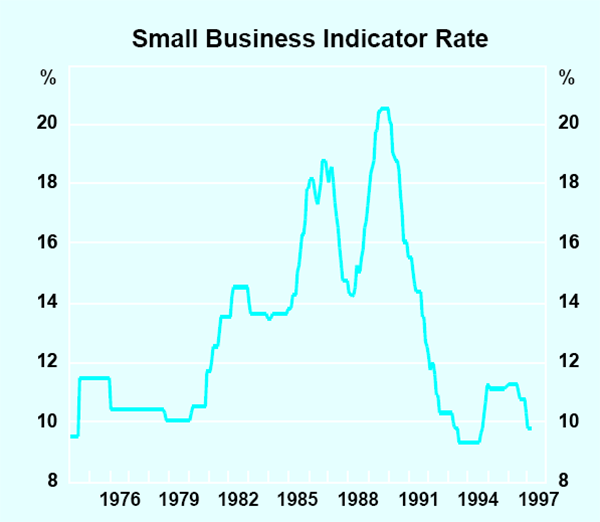
In addition to the changes in interest rates resulting from monetary policy, there are some signs that competition is forcing interest rates on small business loans lower. This is coming about mainly by the introduction of new products at lower interest rates than the standard indicator rate. On average, these new products carry an indicator interest rate about 2 percentage points below the standard rate.
There are some similarities here to developments in the housing loan market some years earlier. In that market, banks initially attempted to meet the competition, particularly from non-bank lenders, by introducing new products at discounted rates for selected customers rather than cutting interest rates on existing loan products. In due course, however, intensifying competition saw banks make more general reductions in rates on all housing loan products. As a result, the spread between the standard variable housing loan rate and the cash rate fell from about 4 percentage points in 1993 to about 1½ percentage points at present.
Small business lending is more difficult than the housing market for non-bank financiers to penetrate because small business loans are less amenable than mortgages to securitisation (because of the variety of risk involved in lending to small business and the wide range of terms and conditions offered). However, moves have been made in recent months by some mortgage managers to expand into business lending, by offering loans to small business secured by a housing mortgage. As these facilities have only recently been introduced, relatively small amounts have been extended under them to date. Nevertheless, this, and the proliferation of products on offer to small business, is evidence of the growing competition in this market segment.
Interest rates applying to new fixed-rate loans have also come down substantially since 1994, reflecting the fall in bond yields over that period. For example, the indicator rate for 3-year fixed-rate loans fell from 11½ per cent in late 1994 to around 9 per cent at present. After allowing for customer risk margins, small businesses would typically be paying between 10 and 11 per cent on these loans at present.
Interest rates on bill lines effectively move in tandem with the yield on bank bills in the money market. Currently, 90-day bill yields are around 6 per cent. After allowing for margins and fees, the typical interest rate paid by small businesses on a bill line at present is about 8.8 per cent.
The statistics collected by the Reserve Bank show that the average interest rate, including customer risk margins, paid by small businesses across all the different types of loan facilities was 10.6 per cent at the end of December 1996. This was 1 percentage point lower than at the peak in early 1995 (Graph 3). A further fall in this average will occur in the March quarter of 1997 as the cuts in indicator rates announced in late 1996 become effective.
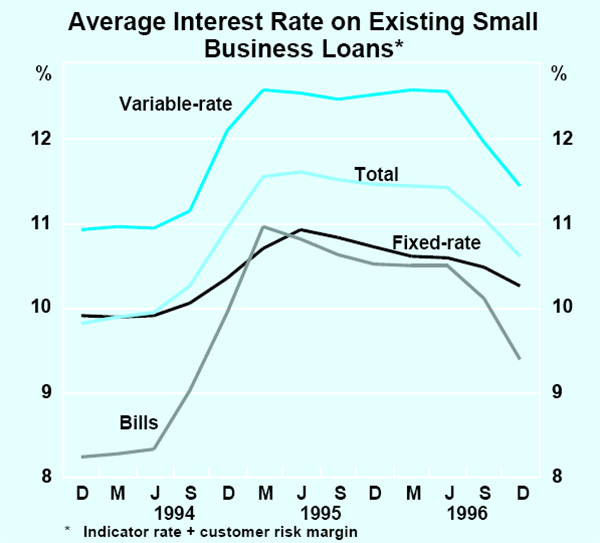
The distribution of interest charges on loans for small business at end December, measured across all loan products, is shown in Graph 4. Again, this was before the latest cut in small business interest rates had become effective, as the reduction was passed on by most banks in January. At end December, while the average (mean) interest rate was 10.6 per cent, the most common rate (mode) on small business loans was between 9 and 10 per cent. Only 5 per cent of loans were at interest rates of more than 13 per cent.
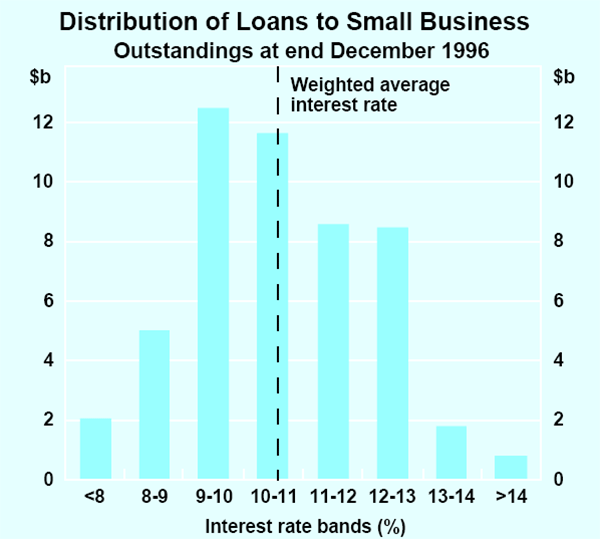
Comparison with Large Businesses
Differences between the total interest cost of a specific financing facility for small and large businesses reflect differences in the indicator interest rates and the customer risk margins. When averaged over the entire range of facilities offered, the different financing pattern of small and large businesses is also important.
The average interest cost to small business for variable-rate loans is just under 2 percentage points higher than that for large businesses (left panel of Graph 5). This reflects a gap between the indicator rates of around 0.45 of a percentage point, and larger risk margins for small business customers. The gap between small and large business in the case of fixed-rate loans is lower, at about 1.25 percentage points.
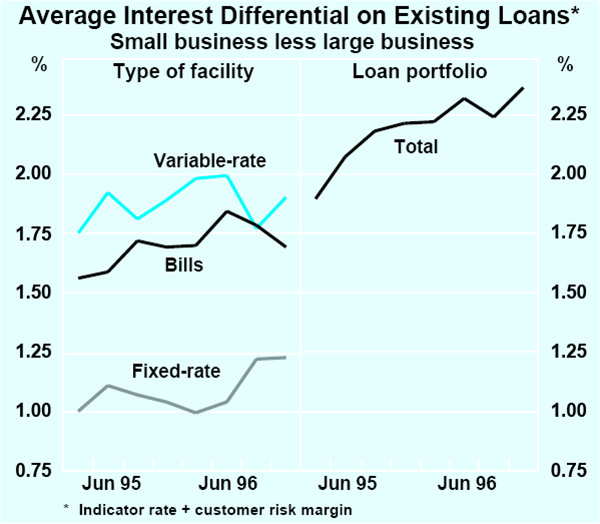
Measured as an aggregate across all loan products, the gap is 2.4 percentage points (right panel of Graph 5). This is larger than the gap on any individual type of loan facility because of differences in the composition of borrowing of small business vis-á-vis large. Borrowing by large business is concentrated in bills, while small businesses use more variable-rate and fixed-rate financing (see below).
Products, Lending Practices and Competition
As noted, there has been substantial change in recent years in the types of loans small businesses are taking out, with use of bill financing falling and fixed-rate financing becoming more common. Bill financing now accounts for about 15 per cent of total small business finance, compared with about one-third in late 1993 (Graph 6). At the same time, the proportion of small business loans outstanding at fixed rates has increased from about one third in late 1993 to almost one half. This trend away from bills appears to be driven to an important degree by lenders. The fact that the shift has been into fixed-rate loans suggests that there may also be demand influences at work, as borrowers lock in what are historically low interest rates.
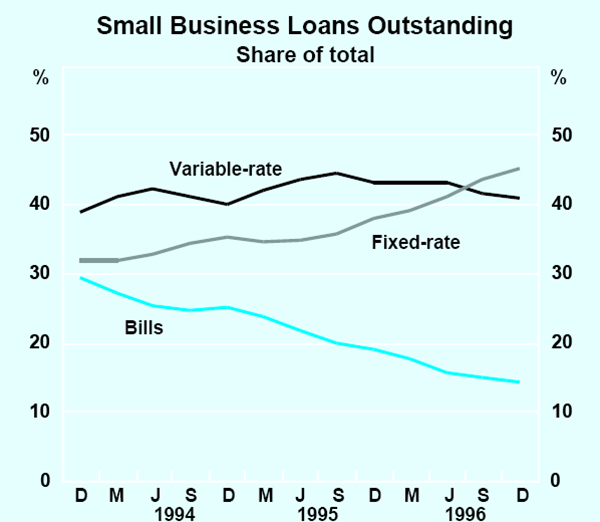
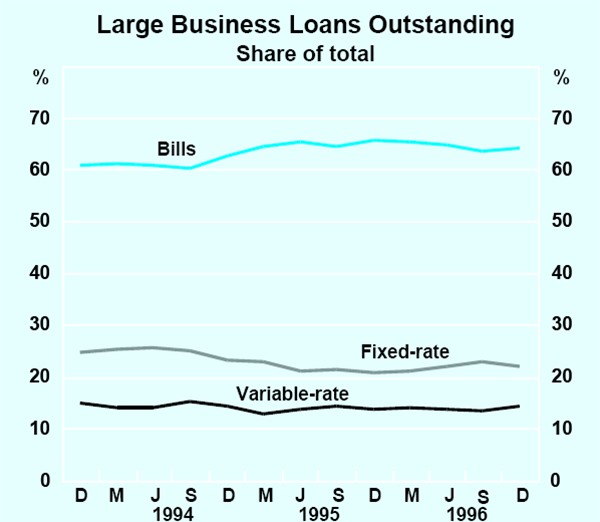
By contrast, the composition of lending to large businesses has been stable and dominated by bill financing, which accounts for almost two-thirds of lending to this sector.
Overall, credit outstanding to small business grew by 4.3 per cent in the year to December 1996, compared with 6 per cent in the previous year. The slowing reflected to an important extent the fairly subdued credit growth in the construction and manufacturing industries. The better conditions expected in the year ahead, particularly in the construction sector, should lead to a pick-up in growth in lending.
The aggregate balance sheet of small businesses seems to be in reasonable shape. Small business' interest cover (defined as the ratio of gross operating surplus relative to interest paid), which had declined to low levels in the recession of 1990/91, has risen strongly in recent years, to its highest level since the mid 1980s (Graph 7). This reflects importantly the reductions in interest rates since the start of the decade. The three easings of monetary policy in the second half of 1996 should see further improvement on this score in coming quarters.
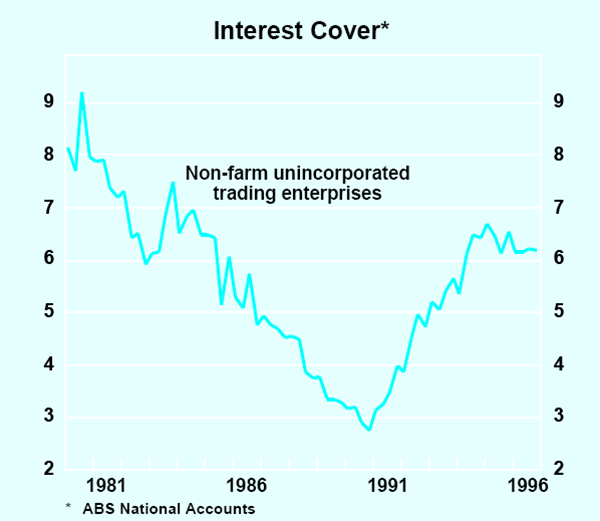
A contentious area remains the assessment of risk in lending to small business, which both underpins the decision to lend and determines the security required by lending institutions. The claim is frequently heard from operators of small businesses that banks do not fully understand borrowers' operations, and are reluctant to lend without real estate, either residential or commercial, as collateral. Banks' response to this claim is that small businesses are riskier on average than large ones. There is inherently greater difficulty in assessing the risk profile of individual small businesses because there is less information, often a short track record and heavy reliance on the skills of the owner/manager. A survey of small and medium sized business carried out by the Department of Foreign Affairs and Trade suggests that the problem of banks being unable to assess small business risk is most evident for exporters, with nearly 30 per cent of respondents reporting some difficulty accessing finance for international activities.
Notwithstanding these issues, the services and products that banks offer to small businesses have improved in recent years. The Yellow Pages surveys of small businesses suggest that they are more satisfied with the provision of bank finance than was the case in the early 1990s. In that period, ‘a lack of bank lending’ was consistently reported by survey respondents as being among their top ten concerns, but since May last year this item has not been mentioned. This conclusion is confirmed by members of the Reserve Bank's Small Business Finance Advisory Panel, who also report that banks' overall performance in the provision of finance has picked up in recent years, though there remains room for improvement.
Banks have sought greater market share in lending to small businesses, partly in response to non-bank competition in the housing loan market which has caused margins in that market to decline. This has encouraged banks to launch new products and, in some circumstances, increase price competition by offering discounts from standard small business indicator rates, waiving establishment fees and reimbursing refinancing costs. These developments are the type of efficiency gains that were envisaged when financial deregulation began more than a decade ago, though they have taken longer to come about than expected at that time and, most likely, they have further to run.
Footnotes
Small business lending is defined as business loans of less than $500,000. [1]
Fees are charged separately for establishing and administering overdrafts and term loans. Reserve Bank calculations suggest that fees on variable-rate loans add around 0.8 of a percentage point annually over a five year period (ie spreading the establishment fee over the term of the loan). Fees on a five-year fixed-rate loan add around 0.5 of a percentage point a year. Fee schedules have not changed significantly in recent years. [2]